Morphostructural, Meteorological and Seismic Factors Controlling Landslides in Weak Rocks: The Case Studies of Castelnuovo and Ponzano (North East Abruzzo, Central Italy)
Abstract
1. Introduction
2. Study Areas
2.1. Regional Setting of the Apennine Piedmont Hilly Area of NE-Abruzzo
2.1.1. Morphostructural Setting
2.1.2. Climate and Meteorological Features
2.1.3. Seismicity
2.2. The Ponzano di Civitella del Tronto Landslide and the Castelnuovo di Campli Landslide
3. Materials and Methods
4. Results
4.1. The Ponzano di Civitella del Tronto Landslide
4.1.1. Geological Model and Morphostructural Setting
4.1.2. Geomorphological Features
4.1.3. Displacement Pattern
4.2. The Castelnuovo di Campli Landslide
4.2.1. Geological Model and Morphostructural Setting
4.2.2. Geomorphological Features
4.2.3. Landslide 3D Modelling
Pre-Landslide Model without Discontinuities
Pre-Landslide Model with Discontinuities
Pre-Landslide Dynamic Analysis of the Model with Discontinuities
Pre-Landslide Model without Discontinuities and with Pore Water Pressures
Post-Landslides Model with Discontinuities
Post-Landslide Dynamic Analysis of the Model with Discontinuities
5. Discussion
- the occurrence of two systems of major joints trending WNW–ESE and WSW–ENE controlled the location, geometry and mechanism of the February 2017 landslide; the distribution of the instability areas along the entire Castelnuovo slope is at the intersection of the main joints, where only minor landslides occurred so far; the post-landslide modelling confirms the instability areas outlining again the most critical one at the intersection of the main joints systems with the main landslide scarp;
- seismic shaking is not found to be a possible triggering factor for the landslide; however, it could have worsened the slope stability, acting as a predisposing factor for rainfall-snowmelt induced landsliding (as largely documented worldwide; e.g., [6]).
- snowfall and melting—worsened by poor water drainage on top of Castelnuovo relief—inducing pore pressure increase in the upper part of the slope are found to be the main triggering factor for this landslide.
6. Concluding Remarks
- the lithology and morphostructural setting (e.g., hog-back relief, mesa relief affected by intersecting major joints) as a predisposing factor for the shape of the landslide scarp and geometry of the landslide (e.g., following the hog-back setting in Ponzano and the intersection of the main joints in Castelnuovo), as well as in the kinematics of the sliding (e.g., topple and sliding following the main joints in the Castelnuovo landslide);
- the seismic shaking, which affected the area during the 2016–2017 Central Italy seismic crisis is not found to have triggered the landslides but seems to have contributed to worsening the stability conditions of the slope acting as a predisposing factor; delayed landslides were triggered by other events (e.g., meteorological), as largely documented worldwide;
- the meteorological events, which affected the area in January–February 2017 (heavy snowfall and rainfall events followed by snowmelt), are found to be the main triggering cause (i.e., inducing the increase of pore water pressure in the slopes).
Author Contributions
Funding
Acknowledgments
Conflicts of Interest
References
- Trigila, A.; Iadanza, C.; Bussettini, M.; Lastoria, B. Dissesto Idrogeologico in Italia: Pericolosità e Indicatori di Rischio, Edizione 2018; ISPRA Rapporti 287; ISPRA: Rome, Italy, 2018; pp. 1–172.
- Canuti, P.; Casagli, N.; Ermini, L.; Fanti, R.; Farina, P. Landslide activity as a geoindicator in Italy: Significance and new perspectives from remote sensing. Environ. Geol. 2004, 45, 907–919. [Google Scholar] [CrossRef]
- Carrara, A.; Crosta, G.; Frattini, P. Geomorphological and historical data in assessing landslide hazard. Earth Surf. Proc. Land. 2003, 28, 1125–1142. [Google Scholar] [CrossRef]
- Segoni, S.; Piciullo, L.; Gariano, S.L. A review of the recent literature on rainfall thresholds for landslide occurrence. Landslides 2018, 15, 1–19. [Google Scholar] [CrossRef]
- Segoni, S.; Rosi, A.; Rossi, G.; Catani, F.; Casagli, N. Analysing the relationship between rainfalls and landslides to define a mosaic of triggering thresholds for regional-scale warning systems. Nat. Hazards Earth Syst. Sci. 2014, 14, 2637–2648. [Google Scholar] [CrossRef]
- Zhang, S.; Zhang, L.M.; Glade, T. Characteristics of earthquake- and rain-induced landslides near the epicenter of Wenchuan earthquake. Eng. Geol. 2014, 175, 58–73. [Google Scholar] [CrossRef]
- Glade, T.; Crozier, M.J. Landslide geomorphology in a changing environment. Geomorphology 2010, 120, 1–2. [Google Scholar] [CrossRef]
- Gariano, S.L.; Guzzetti, F. Landslides in a changing climate. Earth Sci. Rev. 2016, 162, 227–252. [Google Scholar] [CrossRef]
- Alvioli, M.; Melillo, M.; Guzzetti, F.; Rossi, M.; Palazzi, E.; von Hardenberg, J.; Brunetti, M.T.; Peruccacci, S. Implications of climate change on landslide hazard in Central Italy. Sci. Total Environ. 2018, 630, 1528–1543. [Google Scholar] [CrossRef]
- Bozzano, F.; Gambino, P.; Prestininzi, A.; Scarascia Mugnozza, G.; Valentini, G. Ground effects induced by the Umbria-marche earthquakes of September-October 1997, Central Italy. In Proceedings of the 8th International Congress of International Association for Engineering Geology and the Environment, Vancouver, Canada, 21–25 September 1998; Volume, 2, pp. 825–830. [Google Scholar]
- Keefer, D.K. Landslides caused by earthquakes. Geol. Soc. Am. Bull. 1984, 95, 406–421. [Google Scholar] [CrossRef]
- Romeo, R.W. Seismically induced landslide displacements: A predictive model. Eng. Geol. 2000, 58, 337–351. [Google Scholar] [CrossRef]
- Peruccacci, S.; Brunetti, M.T.; Luciani, S.; Vennari, C.; Guzzetti, F. Lithological and seasonal control on rainfall thresholds for the possible initiation of landslides in central Italy. Geomorphology 2012, 139–140, 79–90. [Google Scholar] [CrossRef]
- Sacchini, A.; Faccini, F.; Ferraris, F.; Firpo, M.; Angelini, S. Large-scale landslide and deep-seated gravitational slope deformation of the Upper Scrivia Valley (Northern Apennine, Italy). J. Maps 2016, 12, 344–358. [Google Scholar] [CrossRef]
- Vanneschi, C.; Eyre, M.; Francioni, M.; Coggan, J. The Use of Remote Sensing Techniques for Monitoring and Characterization of Slope Instability. Procedia Eng. 2017, 191, 150–157. [Google Scholar] [CrossRef]
- Francioni, M.; Salvini, R.; Stead, D.; Coggan, J. Improvements in the integration of remote sensing and rock slope modeling. Nat. Hazards 2018, 90, 975–1004. [Google Scholar] [CrossRef]
- Regione Abruzzo. Calamità Naturali. Available online: https://www.regione.abruzzo.it/content/calamitanaturali (accessed on 10 August 2018).
- Di Lena, B.; Giuliano, D. Report Meteorologico del Mese di Gennaio e Febbraio 2017 Nella Regione Abruzzo. Available online: https://docplayer.it/54882937-Report-meteorologico-del-mese-di-gennaio-2017-nella-regione-abruzzo.html (accessed on 7 March 2019).
- Chiaraluce, L.; Di Stefano, R.; Tinti, E.; Scognamiglio, L.; Michele, M.; Casarotti, E.; Cattaneo, M.; De Gori, P.; Chiarabba, C.; Monachesi, G.; et al. The 2016 central Italy seismic sequence: A first look at the mainshocks, aftershocks, and source models. Seismol. Res. Lett. 2017, 88, 757–771. [Google Scholar] [CrossRef]
- National Institute of Geophysics and Volcanology (INGV). ISIDe Working Group (2018) Version 1.0. Available online: http://cnt.rm.ingv.it/ (accessed on 3 August 2018). [CrossRef]
- Piacentini, T.; Galli, A.; Marsala, V.; Miccadei, E. Analysis of Soil Erosion Induced by Heavy Rainfall: A Case Study from the NE Abruzzo Hills Area in Central Italy. Water 2018, 10, 1314. [Google Scholar] [CrossRef]
- Solari, L.; Raspini, F.; Del Soldato, M.; Bianchini, S.; Ciampalini, A.; Ferrigno, F.; Tucci, S.; Casagli, N. Satellite radar data for back-analyzing a landslide event: The Ponzano (Central Italy) case study. Landslide 2018, 15, 773–782. [Google Scholar] [CrossRef]
- Allasia, P.; Baldo, M.; Giordan, D.; Godone, D.; Wrzesniak, A.; Lollino, G. Near Real Time Monitoring Systems and Periodic Surveys Using a Multi Sensors UAV: The Case of Ponzano Landslide. In Proceedings of the IAEG/AEG Annual Meeting, San Francisco, CA, USA, 17–21 September 2018; Springer International Publishing: Cham, Switzerland, 2018; Volume 1, pp. 303–310. [Google Scholar]
- Di Francesco, R.; Siena, M.; Tiberii, M.G.; Labagnara, R.; Di Matteo, L.; Scalella, G. Il contributo della geotecnica nella comprensione dei dissesti storici dell’Abitato di Campli (TE). In Proceedings of the XXII Convegno Nazionale di Geotecnica, Palermo, Italy, 16–18 May 2007. [Google Scholar]
- D’Alessandro, L.; Miccadei, E.; Piacentini, T. Morphostructural elements of central-eastern Abruzzi: Contributions to the study of the role of tectonics on the morphogenesis of the Apennine chain. Quat. Int. 2003, 101–102, 115–124. [Google Scholar] [CrossRef]
- Progetto IFFI (Inventario dei Fenomeni Franosi in Italia) ISPRA-Dipartimento Difesa del Suolo-Servizio Geologico d’Italia–Regione Abruzzo. Available online: http://www.progettoiffi.isprambiente.it/cartanetiffi/ (accessed on 1 December 2018).
- Marchetti, D.; D’Amato Avanzi, G.; Sciarra, N.; Calista, M. Slope stability modeling of a sandstone cliff south of Livorno (Tuscany, Italy). In Risk Analysis VI Simulation and Hazard Mitigation, Proceedings of the 6th International Conference on Computer Simulation Risk Analysis and Hazard Mitigation, Cephalonia, Greece, 5–7 May 2008; Brebbia, C.A., Beriatos, E., Eds.; WitPress: Southampton, UK, 2008; pp. 321–333. [Google Scholar]
- Sciarra, N.; Miccadei, E.; Calista, M.; Marchetti, D. Distinct element analysis of jointed and karstified rocks in a former quarry. In Rock Engineering in Difficult Ground Conditions–Soft Rocks and Karst, Proceedings of the Regional Symposium of the International Society for Rock Mechanics EUROCK 2009, Dubrovnik, Cavtat, Croatia, 29–31 October 2009; Vrkljan, I., Ed.; Leiden CRC Press: Taylor & Francis Group: London, UK, 2010; pp. 507–512. [Google Scholar]
- Sciarra, N.; Calista, M.; Pasculli, A.; Mataloni, G. Numerical modeling and hazard of a cliff in anthropic and historical contexts. In ISRM International Symposium-EUROCK 2016; International Society for Rock Mechanics and Rock Engineering: Ürgüp-Nevşehir, Turkey, 2016. [Google Scholar]
- Aringoli, D.; Calista, M.; Gentili, B.; Pambianchi, G.; Sciarra, N. Geomorphological features and 3d modeling of Montelparo mass movement (Central Italy). Eng. Geol. 2008, 99, 70–84. [Google Scholar] [CrossRef]
- Marchetti, D.; D’amato Avanzi, G.; Pochini, A.; Puccinelli, A.; Sciarra, N.; Calista, M. Geomechanical characterization and 3d numerical modeling of complex rock masses: A study case in Italy. In ISRM International Symposium on Rock Mechanics-SINOROCK2009-“Rock Characterization, Modeling and Engineering Design Methods”; International Society for Rock Mechanics and Rock Engineering: Hong Kong, China, 2009; pp. 216–220. [Google Scholar]
- Pasculli, A.; Sciarra, N.; Esposito, L.; Esposito, A.W. Effects of wetting and drying cycles on mechanical properties of pyroclastic soils. Catena 2017, 156, 113–123. [Google Scholar] [CrossRef]
- .Pasculli, A.; Audisio, C. Cellular Automata Modelling of Fluvial Evolution: Real and Parametric Numerical Results Comparison along River Pellica (NW Italy). Environ. Model. Assess. 2015, 20, 425–441. [Google Scholar] [CrossRef]
- Pasculli, A.; Sciarra, N. A probabilistic approach to determine the local erosion of a watery debris flow. In Proceedings of the XI IAEG International Congress, Liege, Belgium, 3–8 September 2006. [Google Scholar]
- Calista, M.; Pasculli, A.; Sciarra, N. Reconstruction of the geotechnical model considering random parameters distributions. Eng. Geol. Soc. Territ. 2015, 2, 1347–1351. [Google Scholar]
- Pasculli, A.; Calista, M.; Sciarra, N. Variability of local stress states resulting from the application of Monte Carlo and finite difference methods to the stability study of a selected slope. Eng. Geol. 2018, 245, 370–389. [Google Scholar] [CrossRef]
- Pasculli, A.; Minatti, L.; Sciarra, N. Insights on the application of some current SPH approaches for the study of muddy debris flow: Numerical and experimental comparison. In Wit Transaction on Information and Communication Technologies, Proceedings of the 10th International Conference on Advances in Fluid Mechanics, AFM 2014, Coruna, Spain, 1 July 2014; WIT Press: Ashurst, UK, 2014; Volume 82, pp. 3–14. [Google Scholar]
- Jiang, J.; Ehret, D.; Xiang, W.; Rhon, J.; Huang, L.; Yan, S.; Bi, R. Numerical simulation of Qiaotou Landslide deformation caused by drawdown of the Three Gorges Reservoir, China. Environ. Earth Sci. 2011, 62, 411–419. [Google Scholar] [CrossRef]
- Cała, M.; Flisiak, J.; Tajduś, A. Slope stability analysis with FLAC In 2D and 3D. In Proceedings of the 4th International FLAC Symposium on Numerical Methods in Geomechanics, Madrid, Spain, 29–31 May 2006; pp. 11–14. [Google Scholar]
- Shen, H.; Klapperich, H.; Abbas, S.M.; Ibrahim, A. Slope stability ananlisys based on the integration of GIS and numerical simulation. Autom. Constr. 2012, 26, 46–53. [Google Scholar] [CrossRef]
- Zhang, Y.; Zhang, J.; Chen, G.; Zheng, L.; Li, Y. Effects of vertical seismic force on initiation of the Daguangbao landslide induced by the 2008 Wenchuan earthquake. Soil Dyn. Earthq. Eng. 2015, 73, 91–102. [Google Scholar] [CrossRef]
- Islam, S.; Abdullah, R.A.B.; Mallick, J. Static and dynamic analysis of mansa devi hill landslide using flac3D. Int. J. Civ. Eng. Technol. (IJCIET) 2017, 8, 631–643. [Google Scholar]
- Patacca, E.; Scandone, P.; Di Luzio, E.; Cavinato, G.P.; Parotto, M. Structural architecture of the central Apennines: Interpretation of the CROP 11 seismic profile from the Adriatic coast to the orographic divide. Tectonics 2008, 27, TC3006. [Google Scholar] [CrossRef]
- Parotto, M.; Cavinato, G.P.; Miccadei, E.; Tozzi, M. Line CROP 11: Central Apennines. In CROP Atlas: Seismic Reflection Profiles of the Italian Crust; Scrocca, D., Doglioni, C., Innocenti, F., Manetti, P., Mazzotti, A., Bertelli, L., Burbi, L., D’Offizi, S., Eds.; Istituto Superiore per la Protezione e la Ricerca Ambientale: Roma, Italy. Available online: http://www.isprambiente.gov.it/en/publications/technical-periodicals/descriptive-memories-of-the-geological-map-of/crop-atlas-seismic-reflection-profiles-of-the (accessed on 10 September 2018).
- Miccadei, E.; Piacentini, T.; Buccolini, M. Long-term geomorphological evolution in the Abruzzo area (Central Apennines, Italy): Twenty years of research. Geol. Carpath. Carpathica 2017, 68, 19–28. [Google Scholar] [CrossRef]
- Piacentini, T.; Miccadei, E. The role of drainage systems and intermontane basins in the Quaternary landscape of the Central Apennines chain (Italy). Rend. Lincei 2014, 25, 139–150. [Google Scholar] [CrossRef]
- Regione Abruzzo. Modello Digitale del Terreno-Risoluzione 10 × 10 Metri. Available online: http://opendata.regione.abruzzo.it/opendata/Modello_digitale_del_terreno_risoluzione_10x10_metri (accessed on 10 February 2019).
- Santo, A.; Ascione, A.; Di Crescenzo, G.; Miccadei, E.; Piacentini, T.; Valente, E. Tectonic-geomorphological map of the middle Aterno River valley (Abruzzo, Central Italy). J. Maps 2014, 10, 365–378. [Google Scholar] [CrossRef]
- Miccadei, E.; Mascioli, F.; Ricci, F.; Piacentini, T. Geomorphology of soft clastic rock coasts in the mid western Adriatic Sea (Abruzzo, Italy). Geomorphology 2019, 324, 72–94. [Google Scholar] [CrossRef]
- ISPRA. Carta Geologica d’Italia alla Scala 1:50.000, Foglio 339 “Teramo”. Serv. Geol. Ital. 2012. Available online: http://www.isprambiente.it/Media/carg/339_TERAMO/Foglio.html (accessed on 10 February 2019).
- Della Seta, M.; Del Monte, M.; Fredi, P.; Miccadei, E.; Nesci, O.; Pambianchi, G.; Piacentini, T.; Troiani, F. Morphotectonic evolution of the Adriatic piedmont of the Apennines: An advancement in the knowledge of the Marche-Abruzzo border area. Geomorphology 2008, 102, 119–129. [Google Scholar] [CrossRef]
- Miccadei, E.; Piacentini, T.; Gerbasi, F.; Daverio, F. Morphotectonic map of the Osento River basin (Abruzzo, Italy), scale 1:30,000. J. Maps 2012, 8, 62–73. [Google Scholar] [CrossRef]
- Miccadei, E.; Piacentini, T.; Pozzo, A.D.; Corte, M.L.; Sciarra, M. Morphotectonic map of the Aventino-Lower Sangro valley (Abruzzo, Italy), scale 1:50,000. J. Maps 2013, 9, 390–409. [Google Scholar] [CrossRef]
- Capelli, G.; Miccadei, E.; Raffi, R. Fluvial dynamics in the Castel di Sangro plain: Morphological changes and human impact from 1875 to 1992. Catena 1997, 30, 295–309. [Google Scholar] [CrossRef]
- Ciccacci, S.; D’Alessandro, L.; Dramis, F.; Miccadei, E. Geomorphologic Evolution and Neotectonics of the Sulmona Intramontane Basin (Abruzzi, Apennine, Central Italy). Zeitschrift. Geomorphol. 1999, 118, 27–40. [Google Scholar]
- Calista, M.; Miccadei, E.; Pasculli, A.; Piacentini, T.; Sciarra, M.; Sciarra, N. Geomorphological features of the Montebello sul Sangro large landslide (Abruzzo, Central Italy). J. Maps 2016, 12, 882–891. [Google Scholar] [CrossRef]
- Buccolini, M.; Gentili, B.; Materazzi, M.; Piacentini, T. Late Quaternary geomorphological evolution and erosion rates in the clayey peri-Adriatic belt (central Italy). Geomorphology 2010, 116, 145–161. [Google Scholar] [CrossRef]
- Regione Abruzzo, Piano Stralcio di Bacino per l’Assetto Idrogeologico dei Bacini di Rilievo Regionale Abruzzesi e del Bacino del Fiume Sangro. Servizio Difesa del Suolo Regione Abruzzo. (B.U.R.A. n. 8, 04.02.2005, Modification in 2010). Available online: http://autoritabacini.regione.abruzzo.it/index.php/pai (accessed on 15 December 2018).
- Peel, M.C.; Finlayson, B.L.; McMahon, T.A. Updated world map of the Köppen-Geiger climate classification. Hydrol. Earth Syst. Sci. 2007, 11, 1633–1644. [Google Scholar] [CrossRef]
- Di Lena, B.; Antenucci, F.; Mariani, L. Space and time evolution of the Abruzzo precipitation. Ital. J. Agrometeorol. 2012, 1, 5–20. [Google Scholar]
- Mariani, L.; Parisi, S.G. Extreme rainfalls in the Mediterranean area. Adv. Nat. Technol. Hazards 2014, 39, 17–37. [Google Scholar]
- Rovida, A.; Locati, M.; Camassi, R.; Lolli, B.; Gasperini, P. CPTI15, the 2015 Version of the Parametric Catalogue of Italian Earthquakes; INGV: Bologna, Italy, 2016. [Google Scholar] [CrossRef]
- Locati, M.; Camassi, R.; Rovida, A.; Ercolani, E.; Bernardini, F.; Castelli, V.; Caracciolo, C.H.; Tertulliani, A.; Rossi, A.; Azzaro, R.; et al. DBMI15, the 2015 Version of the Italian Macroseismic Database; INGV: Bologna, Italy, 2016. [Google Scholar] [CrossRef]
- Regione Abruzzo, Comune di Campli, Commissario Straordinario Ricostruzione Sisma–2016. Microzonazione Sismica di Livello 3 del Comune di Campli ai Sensi dell’Ordinanza del Commissario Straordinario n.24 Registrata il 15 Maggio 2017 al n. 1065. Relazione Finale. Di Antonio A. Cruciani D. Available online: http://www.sisma2016abruzzo.it/index.php/11-informazioni-di-servizio/98-microzonazione-sismica-di-iii-livello/te/campli/67008_Campli.zip (accessed on 3 September 2018).
- Rossi, G.; Tanteri, L.; Tofani, V.; Vannocci, P.; Moretti, S.; Casagli, N. Multitemporal UAV surveys for landslide mapping and characterization. Landslides 2018, 15, 1045–1052. [Google Scholar] [CrossRef]
- Giordan, D.; Manconi, A.; Tannant, D.D.; Allasia, P. UAV: Low-cost remote sensing for high-resolution investigation of landslides. In Proceedings of the 2015 IEEE International Geoscience and Remote Sensing Symposium (IGARSS), Milan, Italy, 26–31 July 2015. [Google Scholar]
- Casagli, N.; Frodella, W.; Morelli, S.; Tofani, V.; Ciampalini, A.; Intrieri, E.; Raspini, F.; Rossi, G.; Tanteri, L.; Lu, P. Spaceborne, UAV and ground-based remote sensing techniques for landslide mapping, monitoring and early warning. Geoenviron. Disasters 2017, 4, 1–23. [Google Scholar] [CrossRef]
- Itasca. Fast Lagrangian Analysis of Continua in 3-Dimension (FLAC3D V 5.01); Itasca Consulting Group: Minneapolis, MN, USA, 2012. [Google Scholar]
- Luzi, L.; Pacor, F.; Puglia, R. Italian Accelerometric Archive v 2.3; Istituto Nazionale di Geofisica e Vulcanologia: Roma, Italy, 2017. [Google Scholar]
- Bindi, D.; Pacor, F.; Luzi, L.; Puglia, R.; Massa, M.; Ameri, G.; Paolucci, R. Ground motion prediction equations derived from the Italian strong motion database. Bull. Earthq. Eng. 2011, 9, 1899–1920. [Google Scholar] [CrossRef]
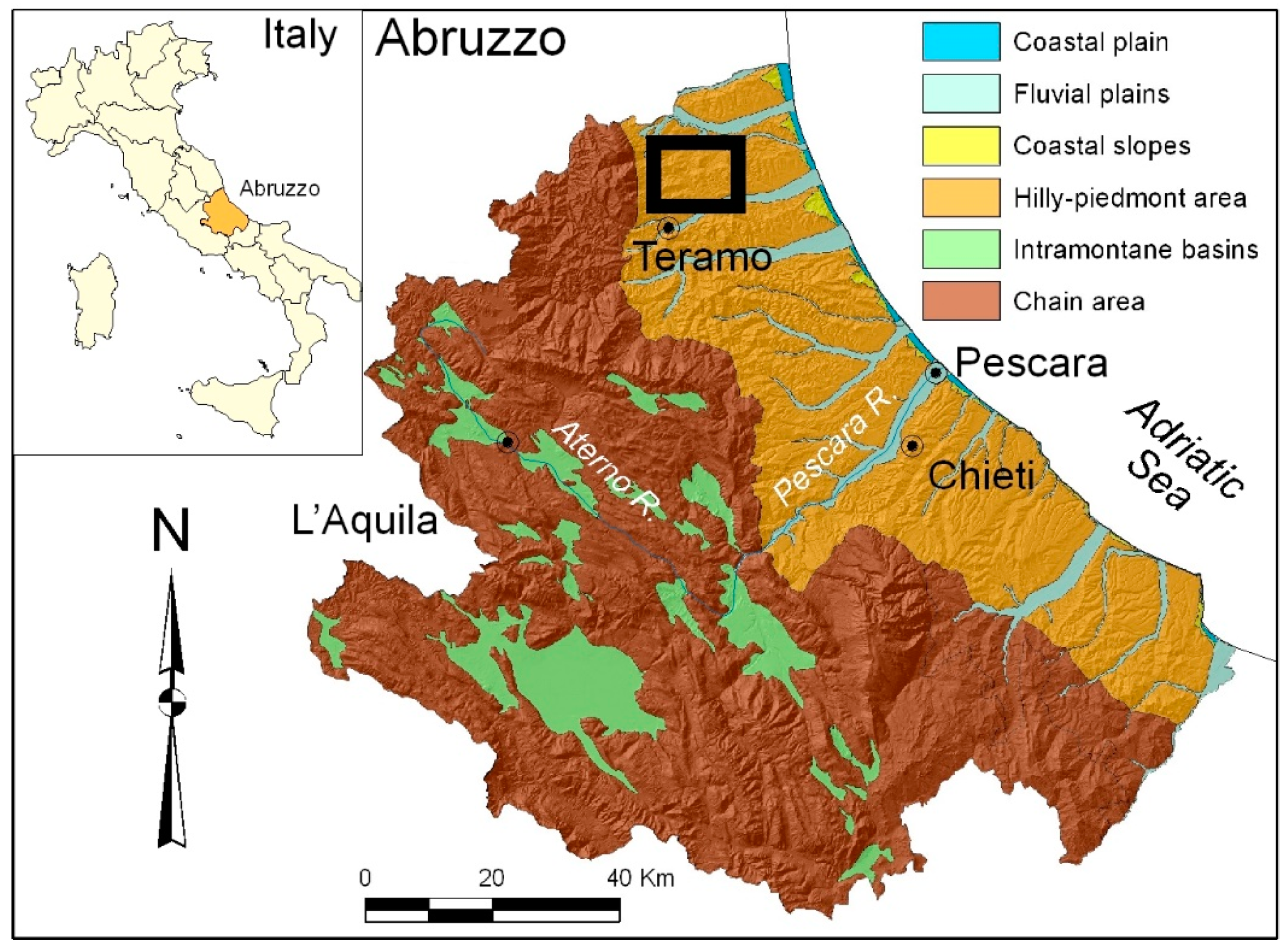
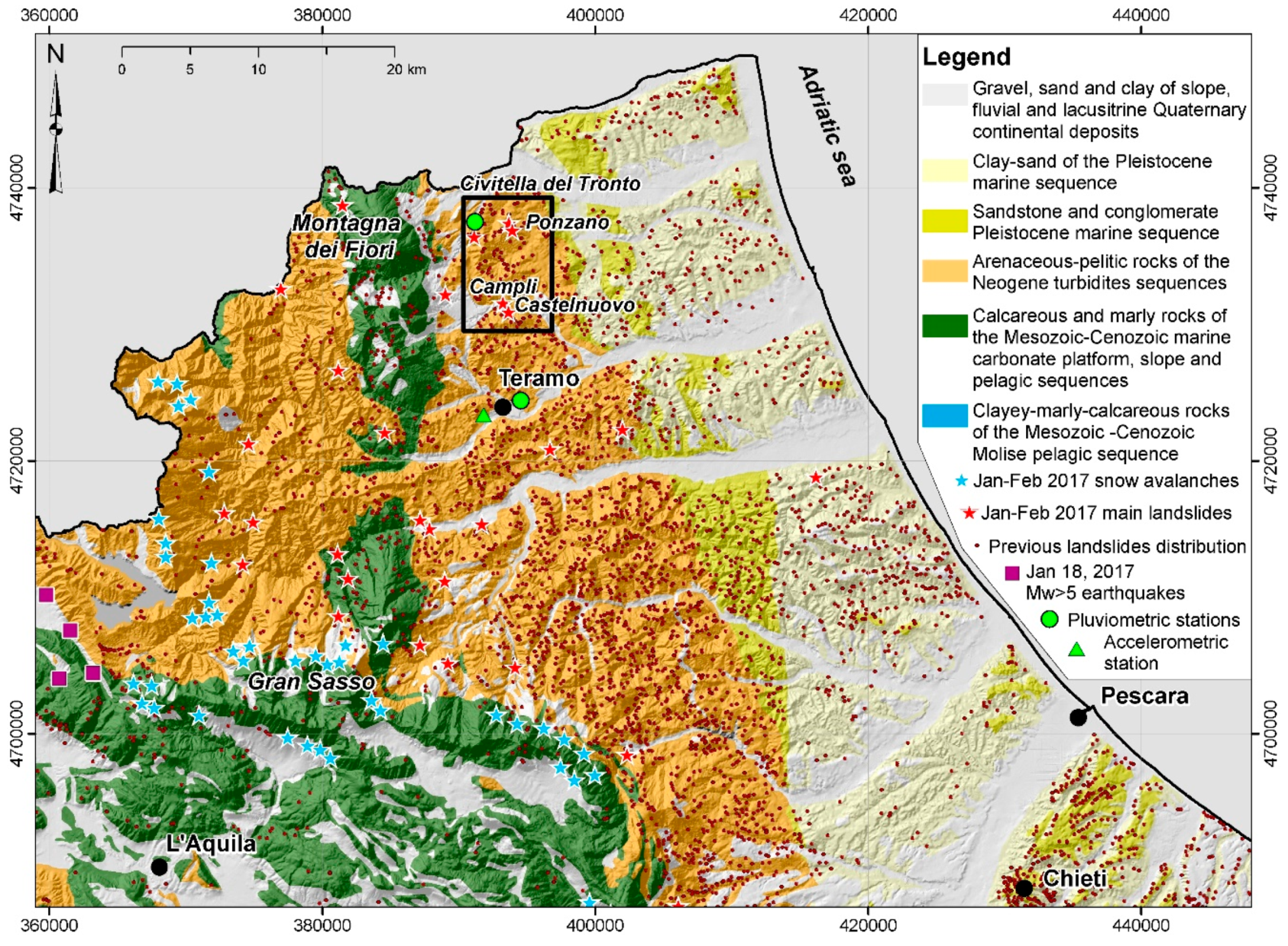
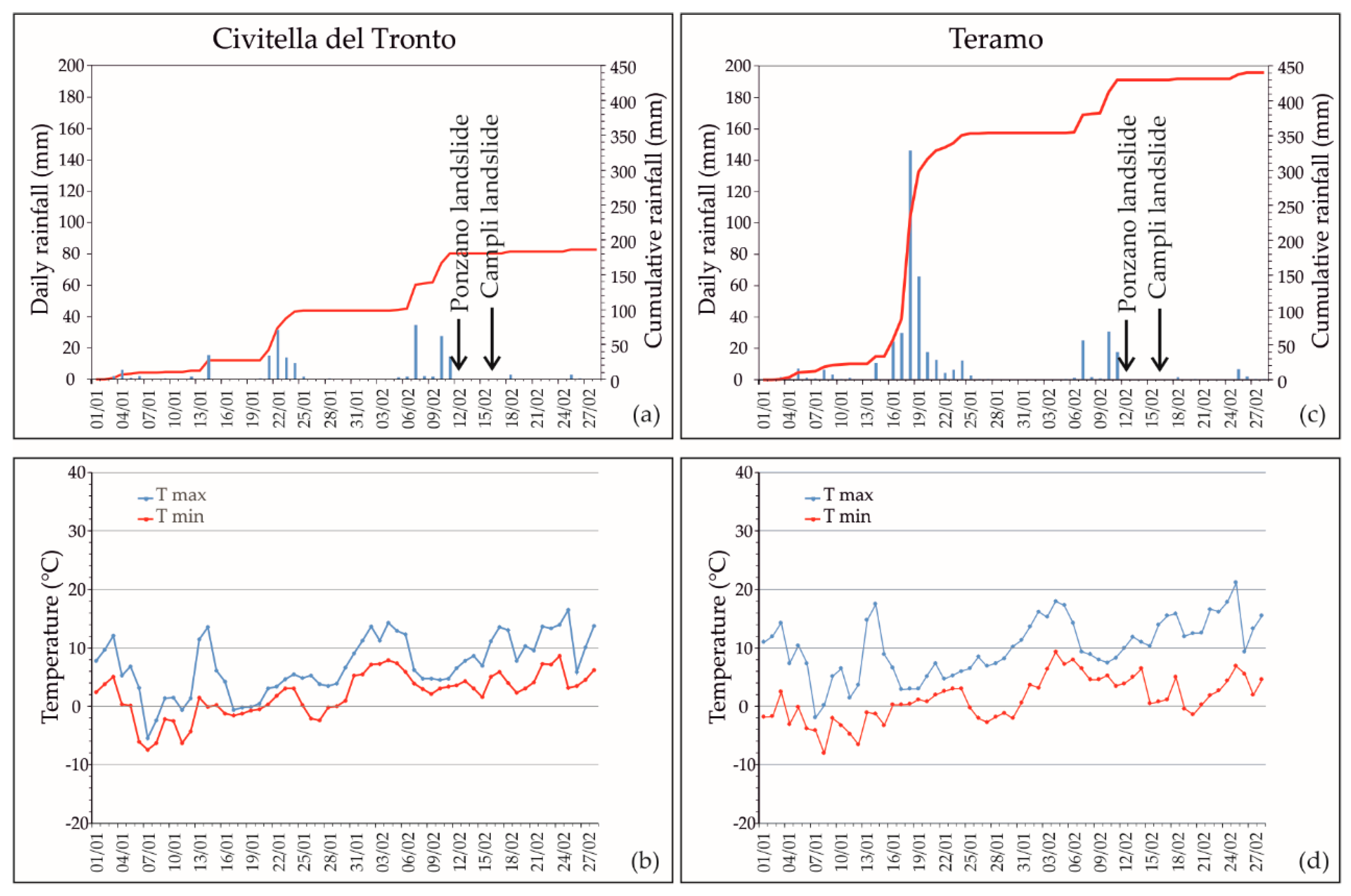
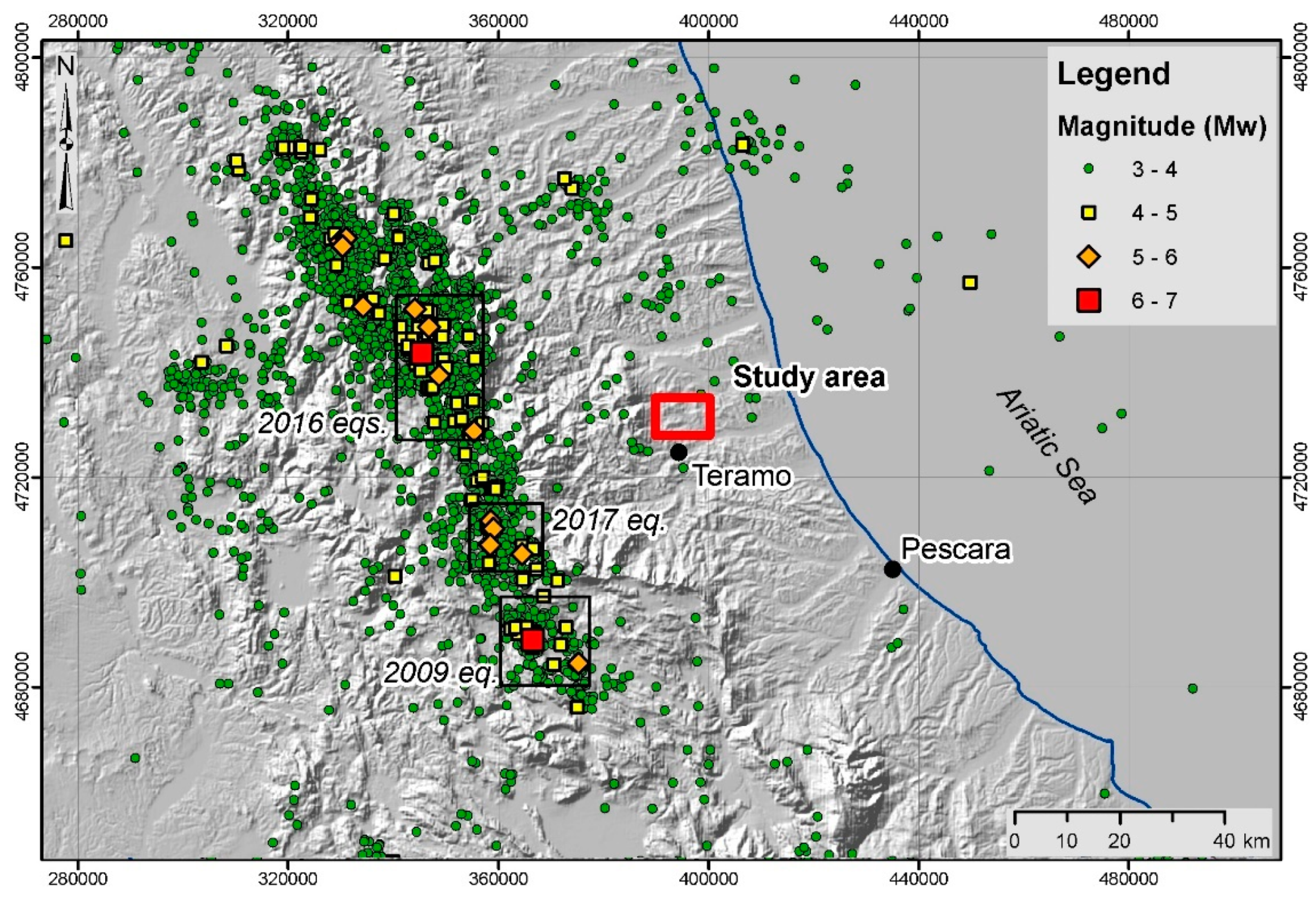
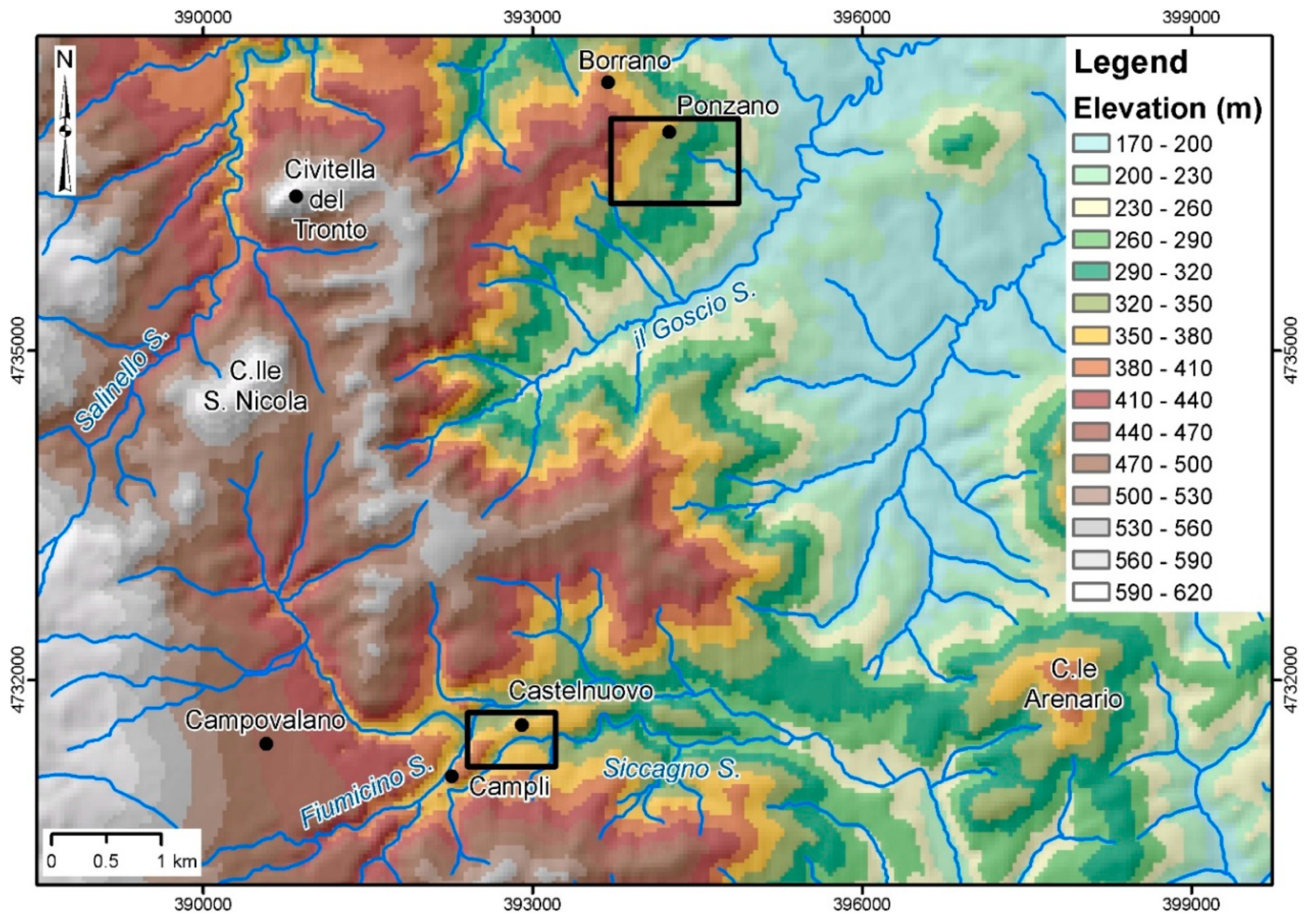
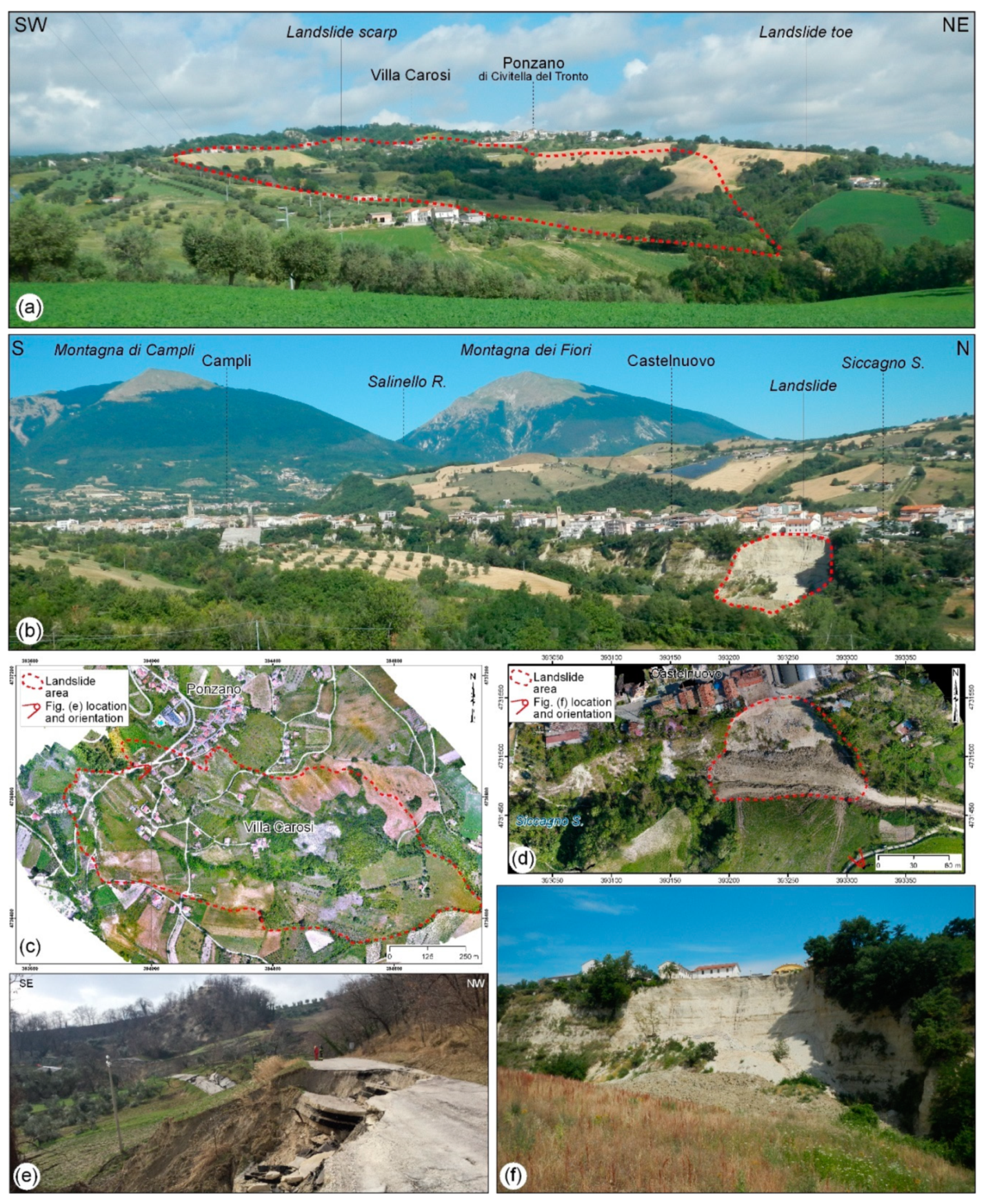
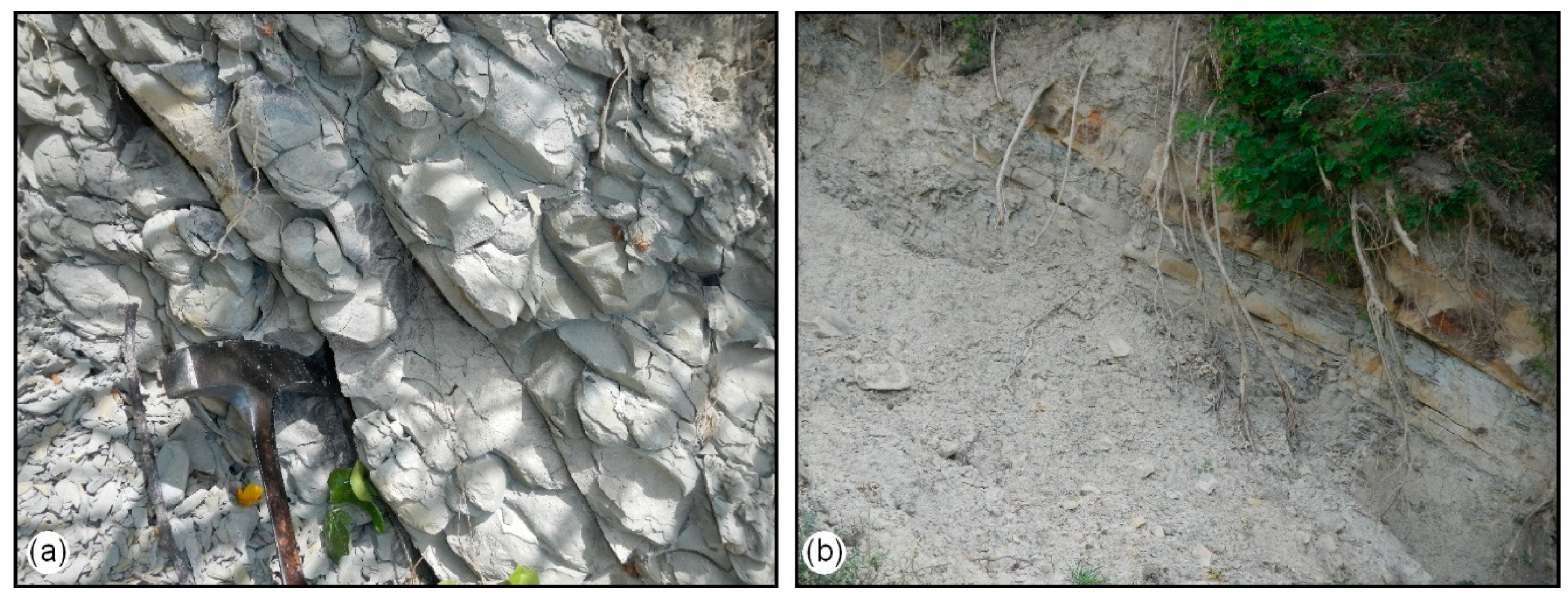
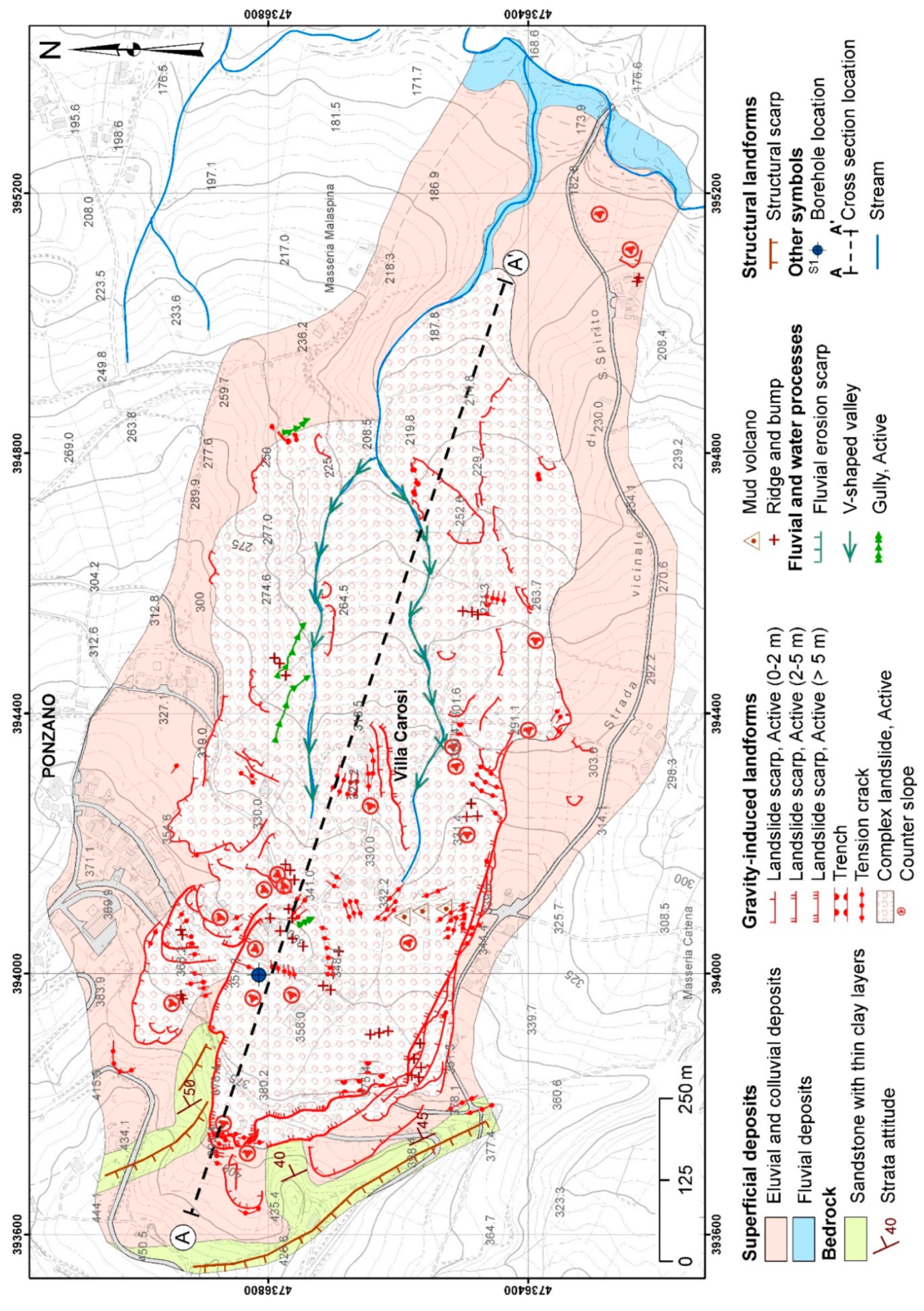
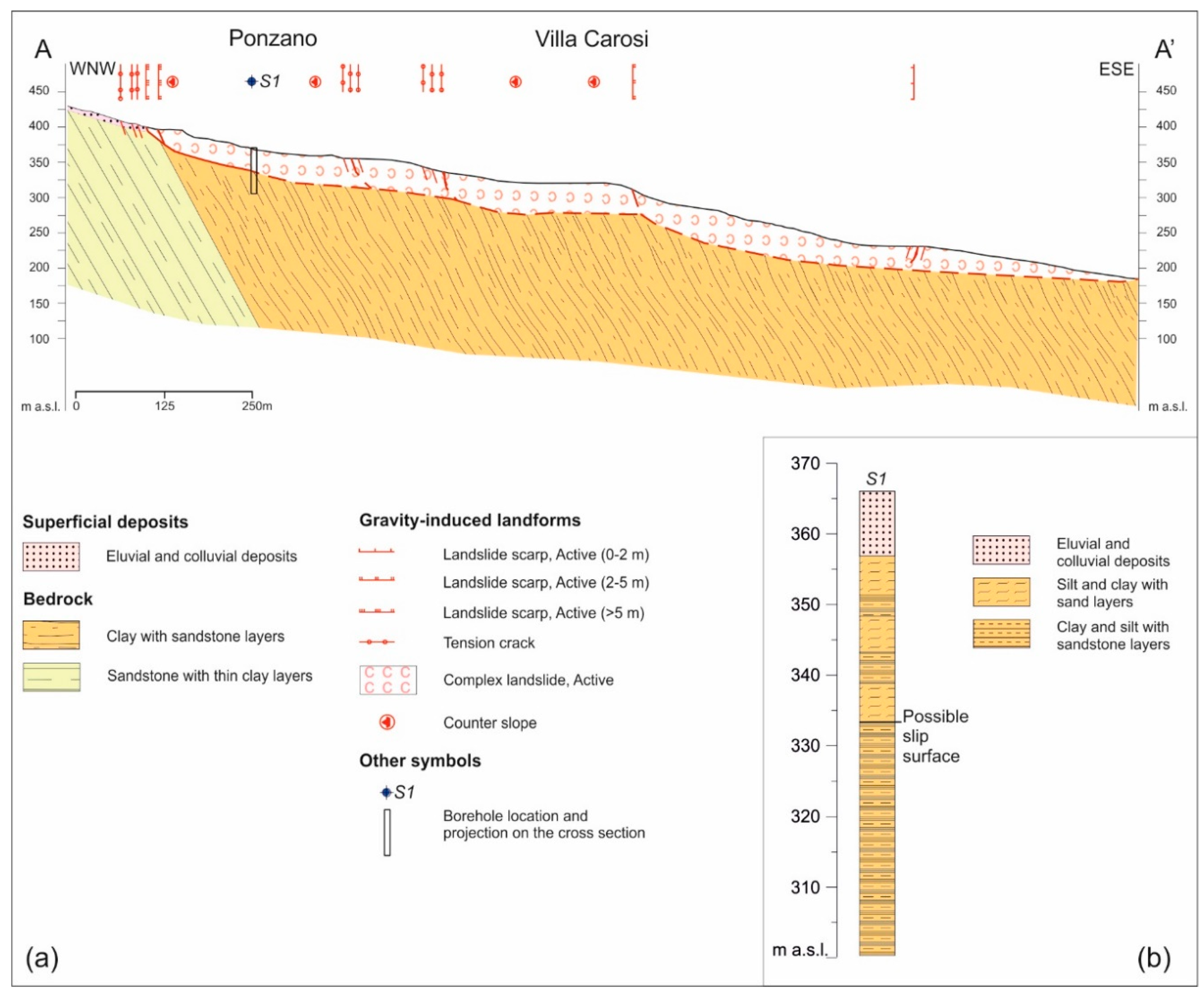
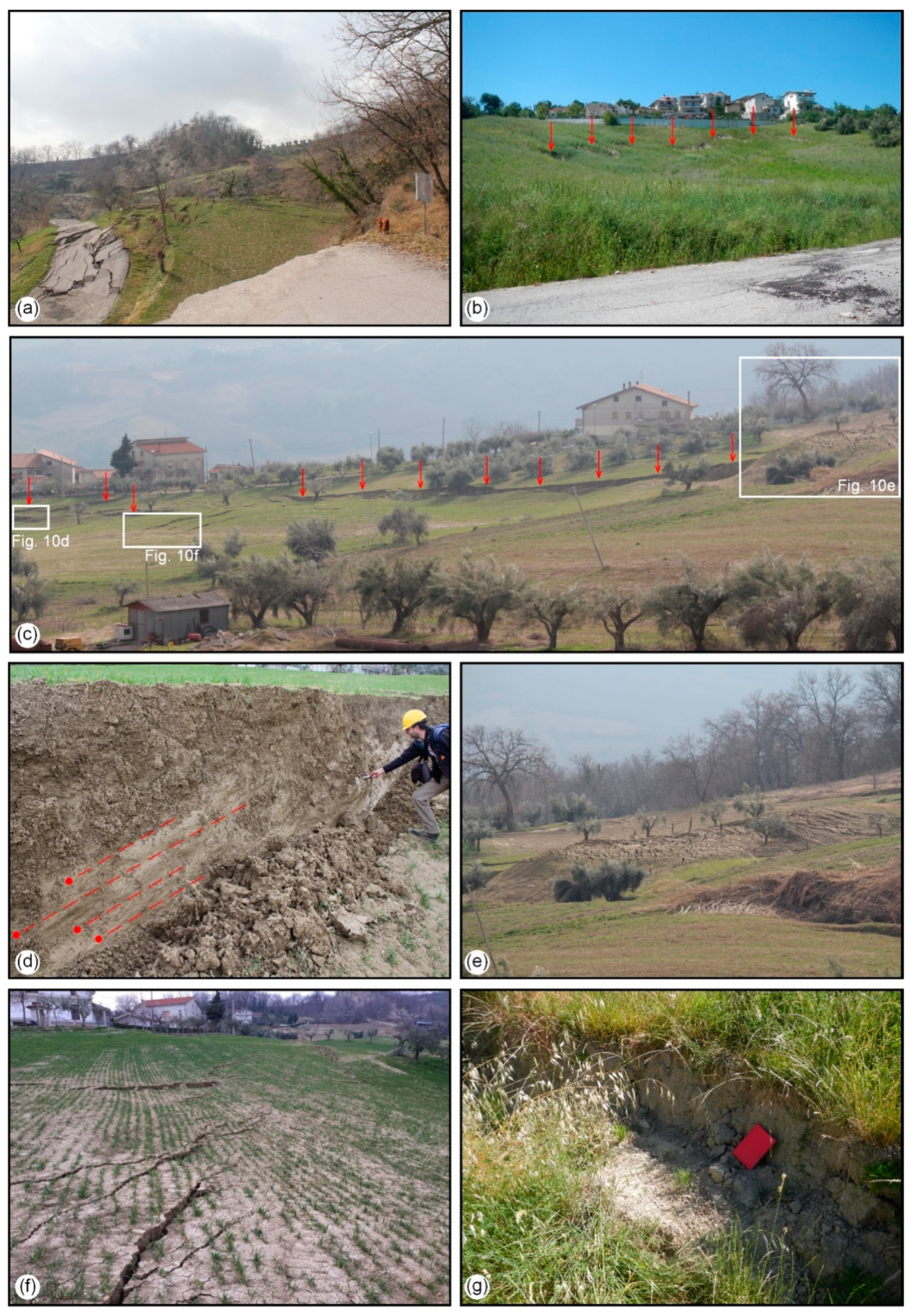
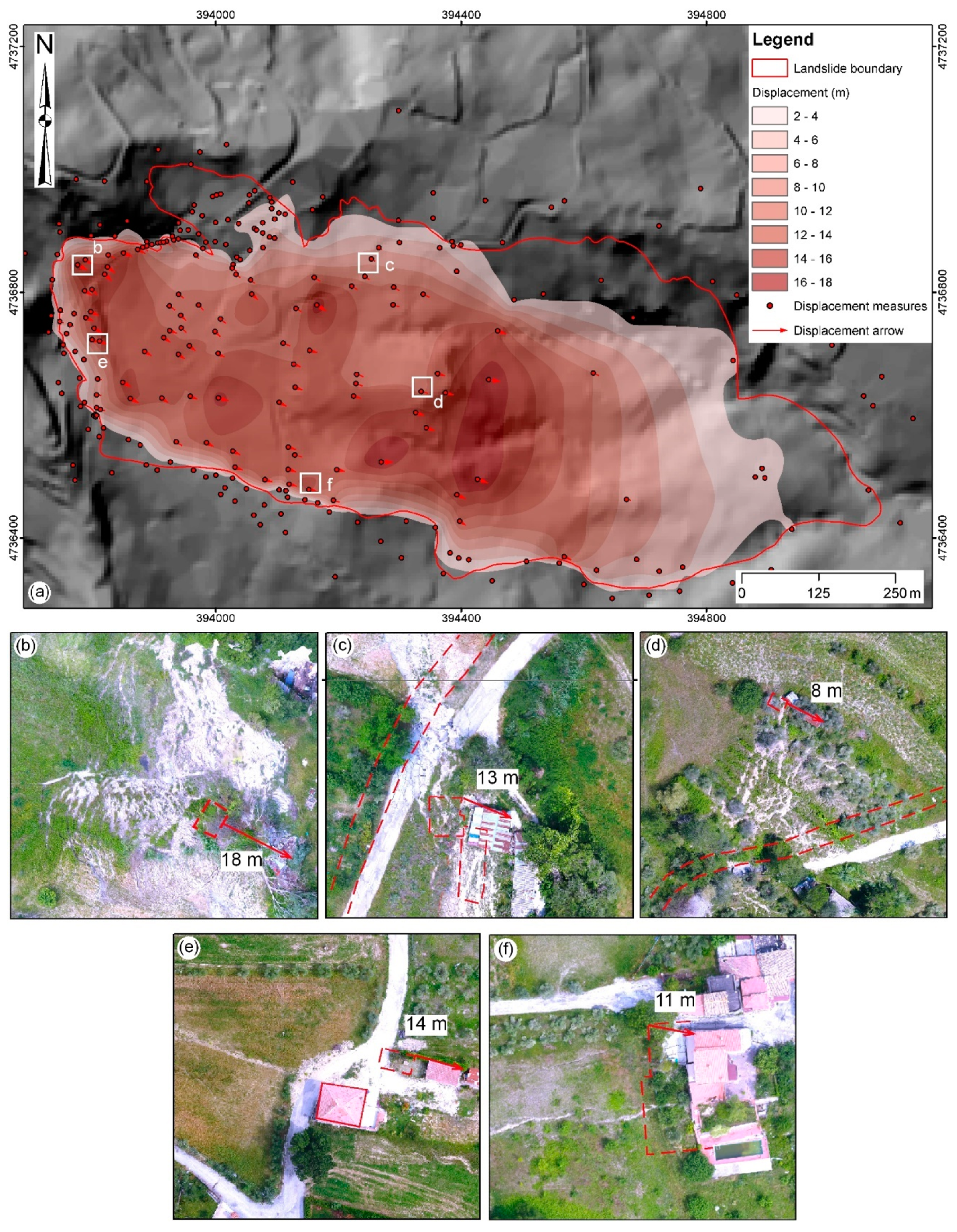
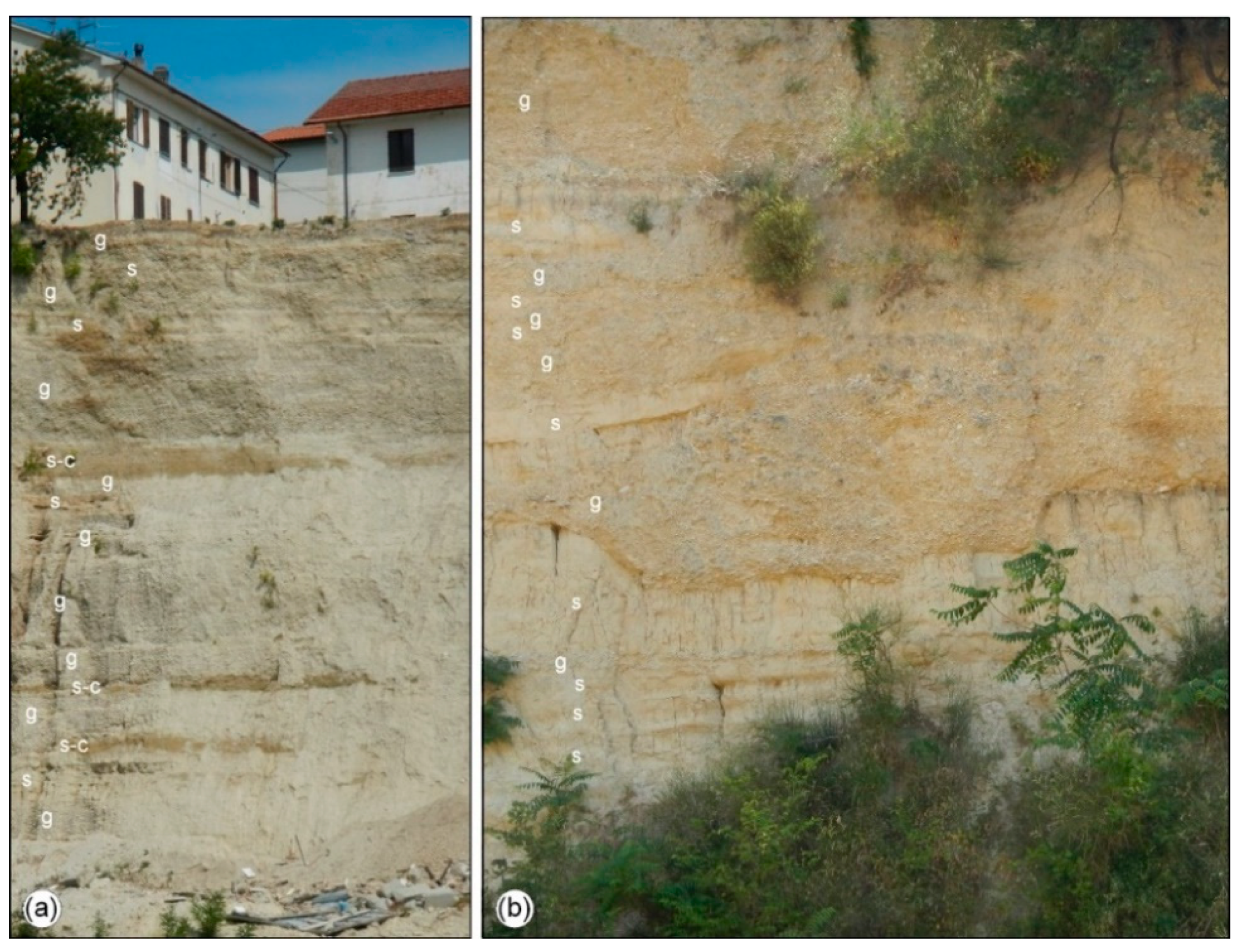
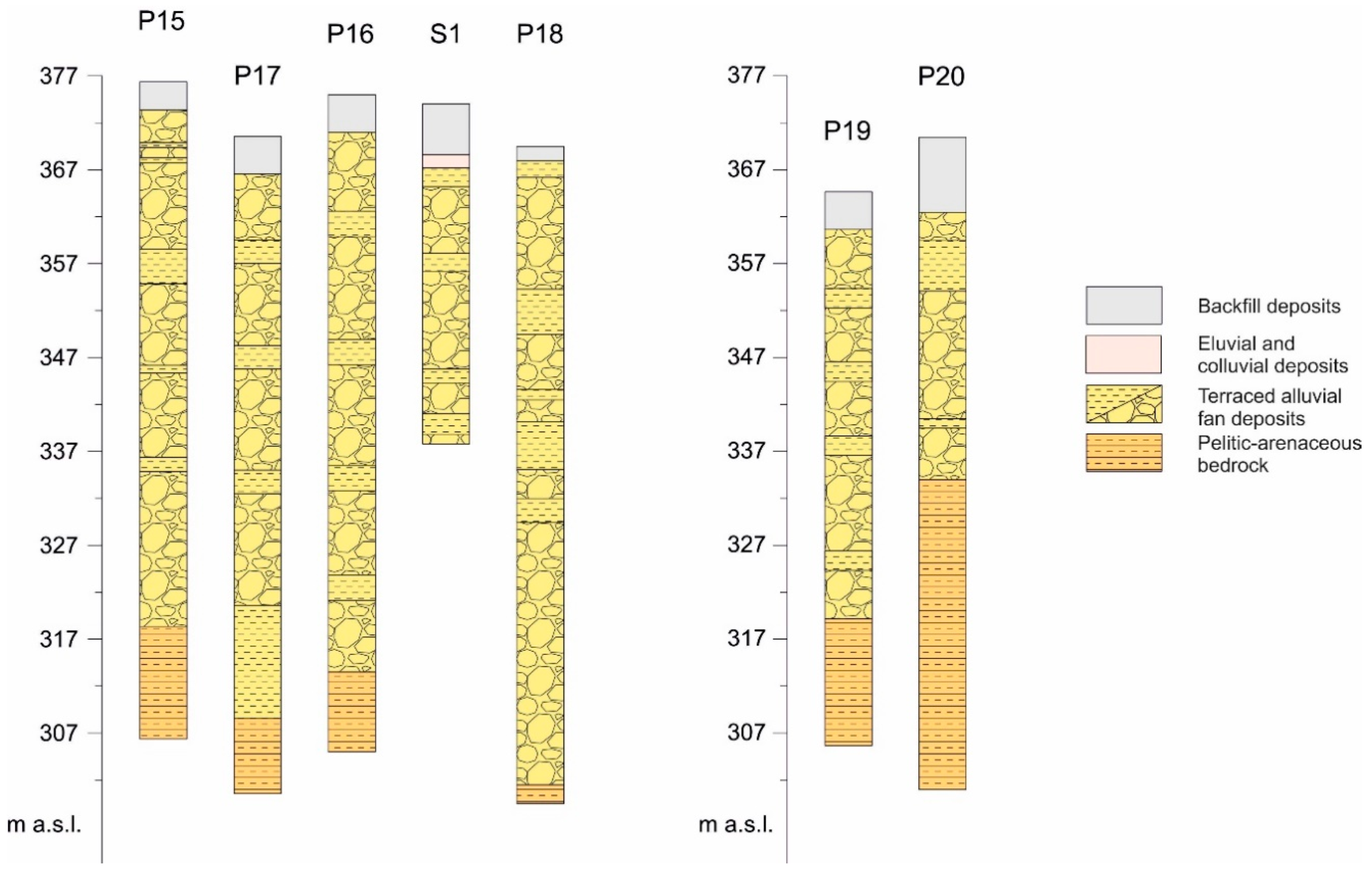
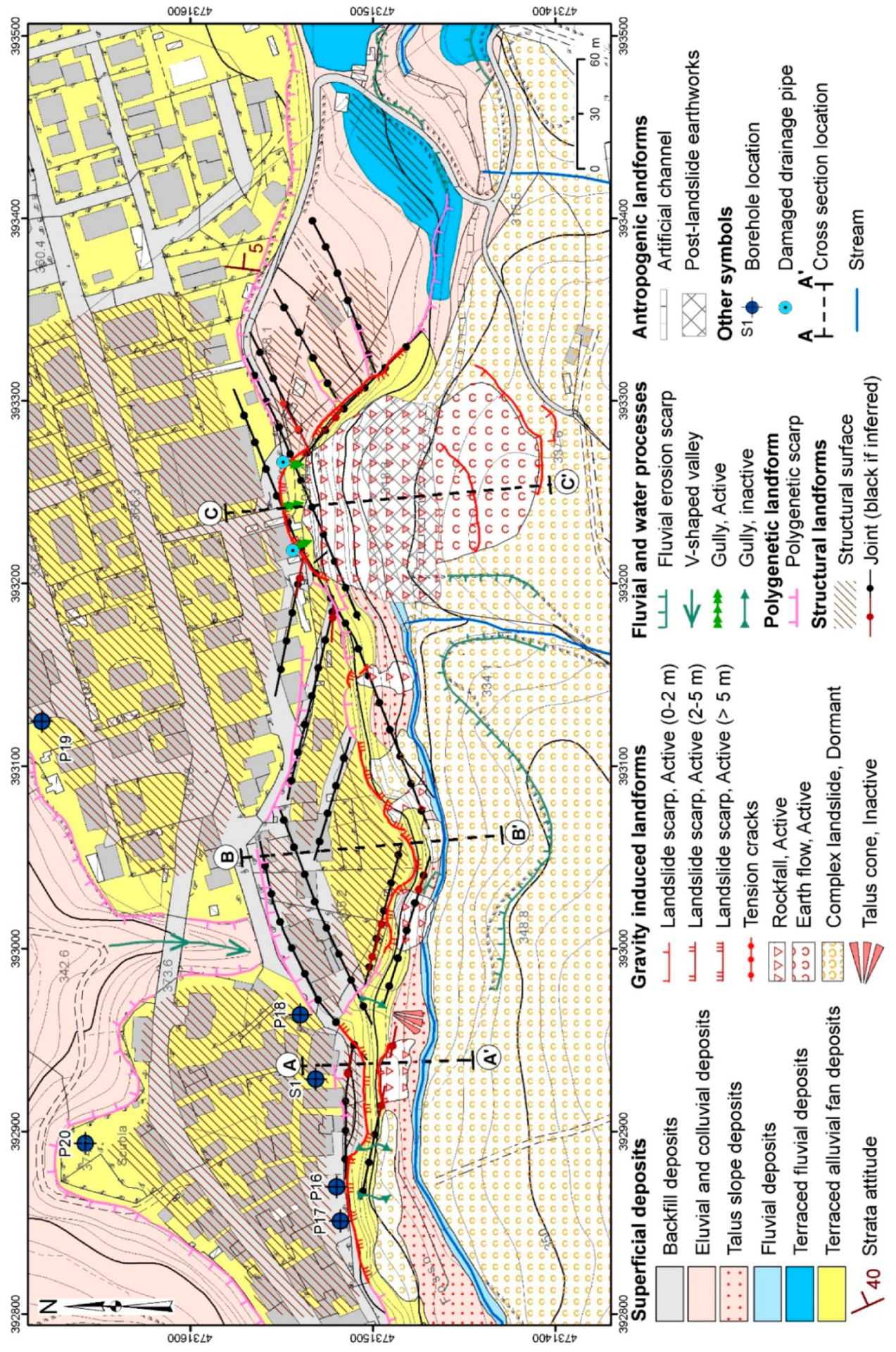
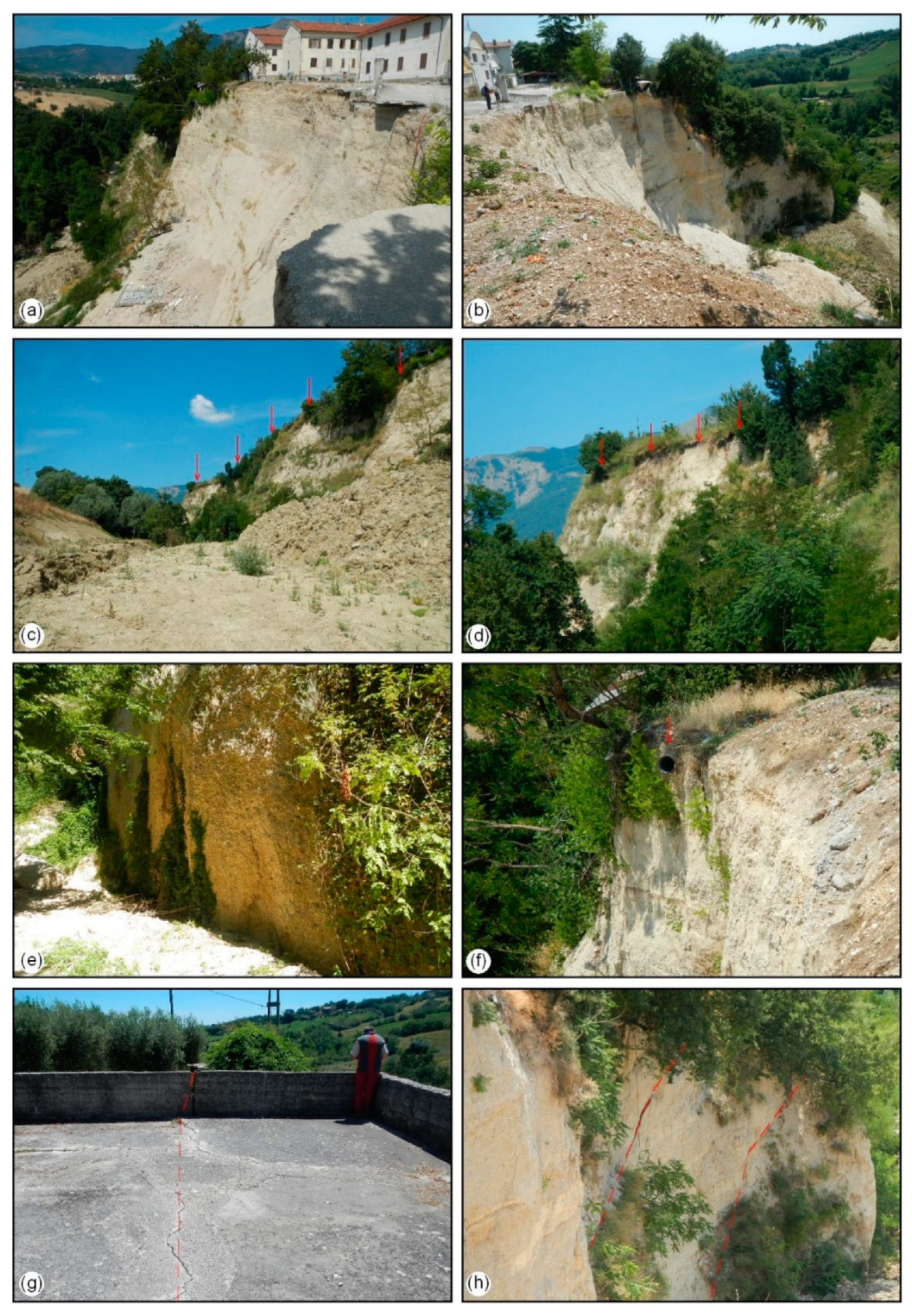

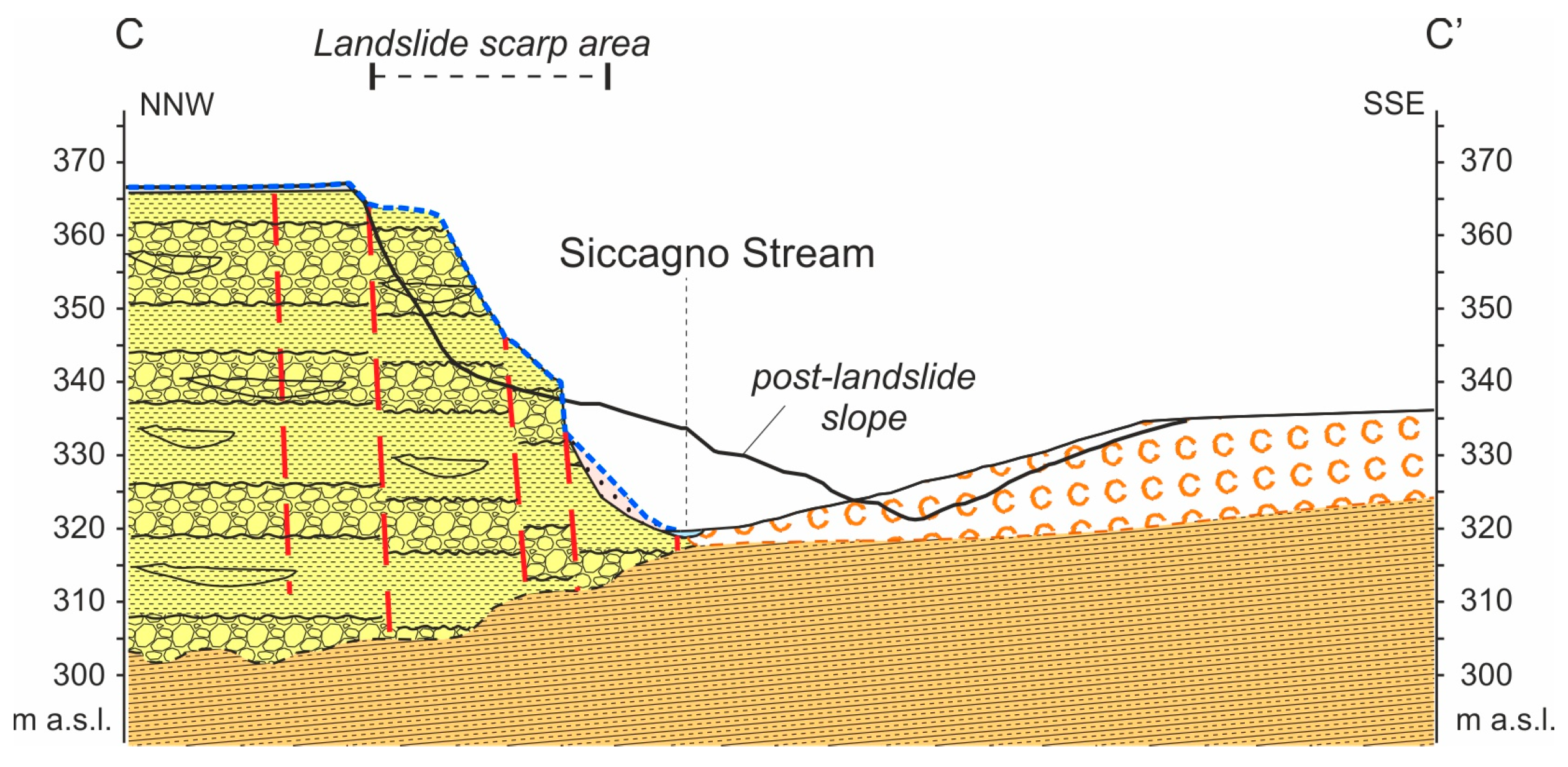
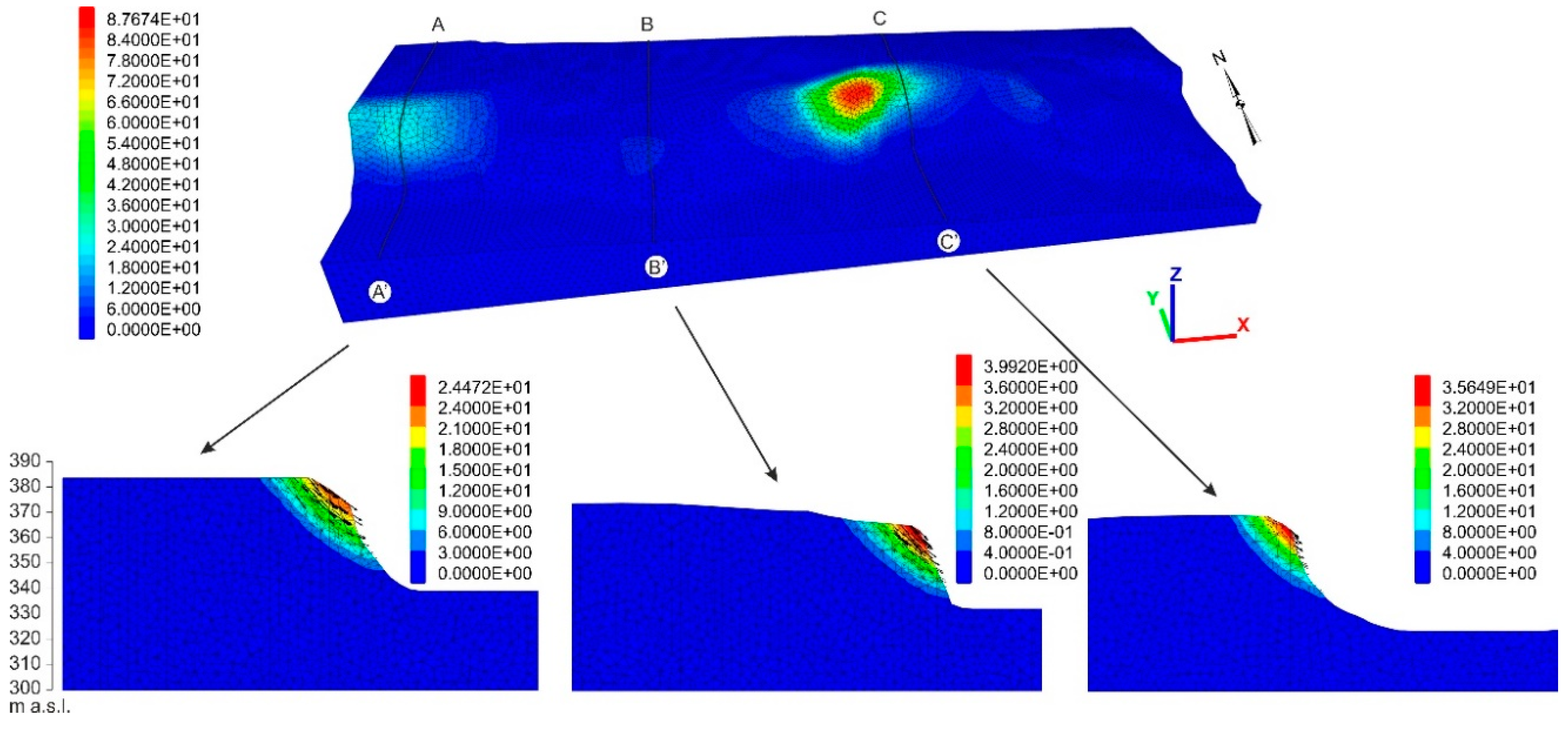
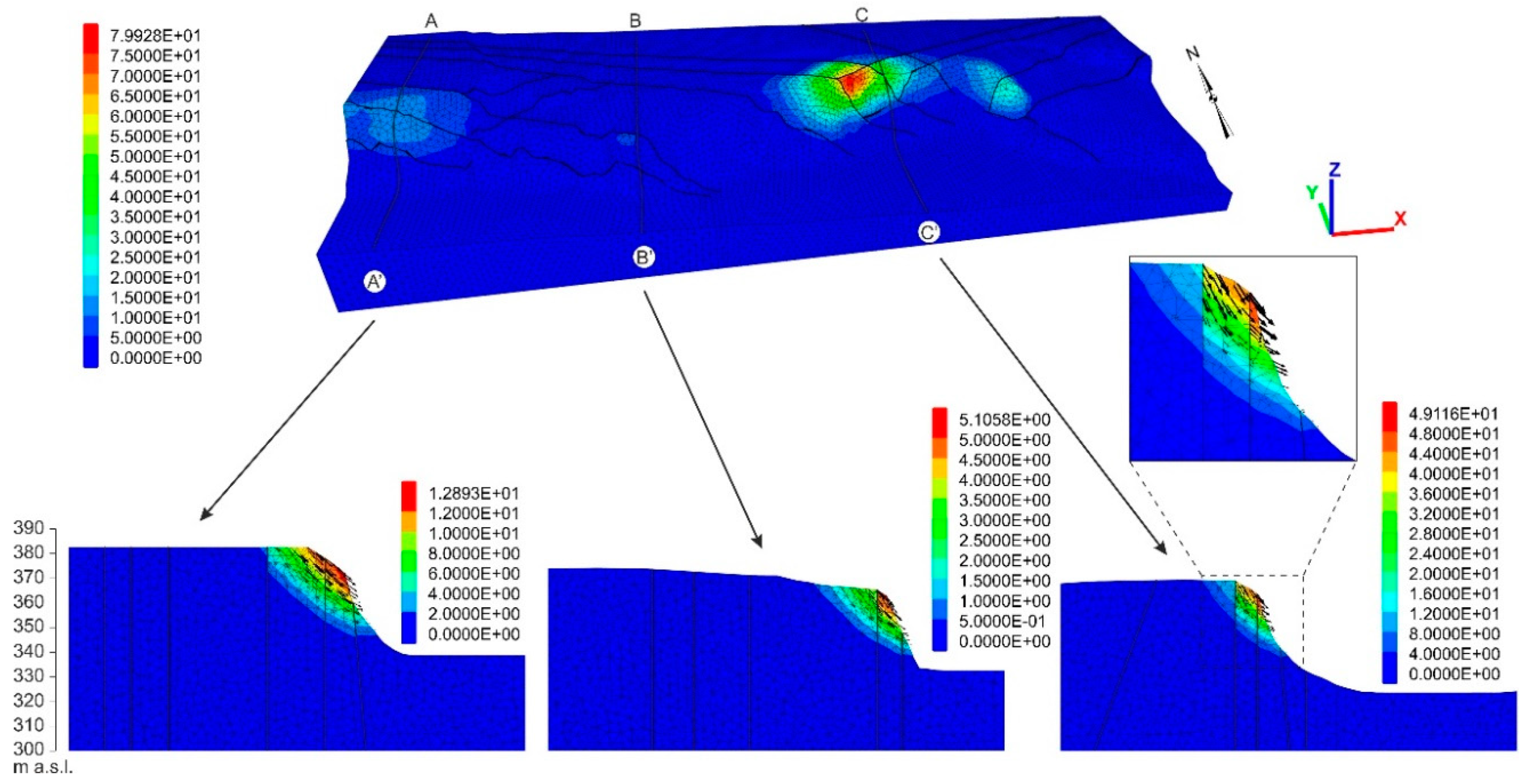
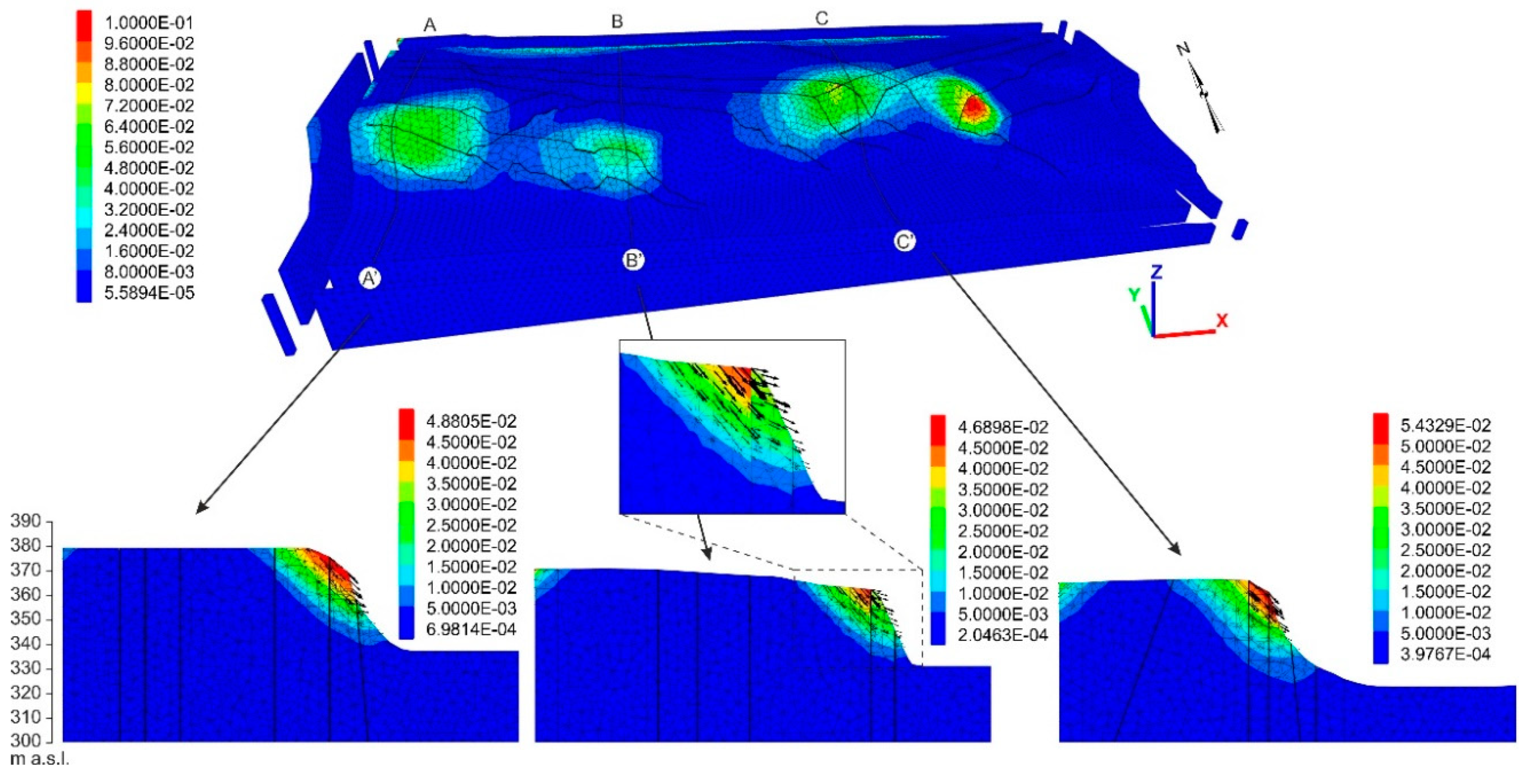

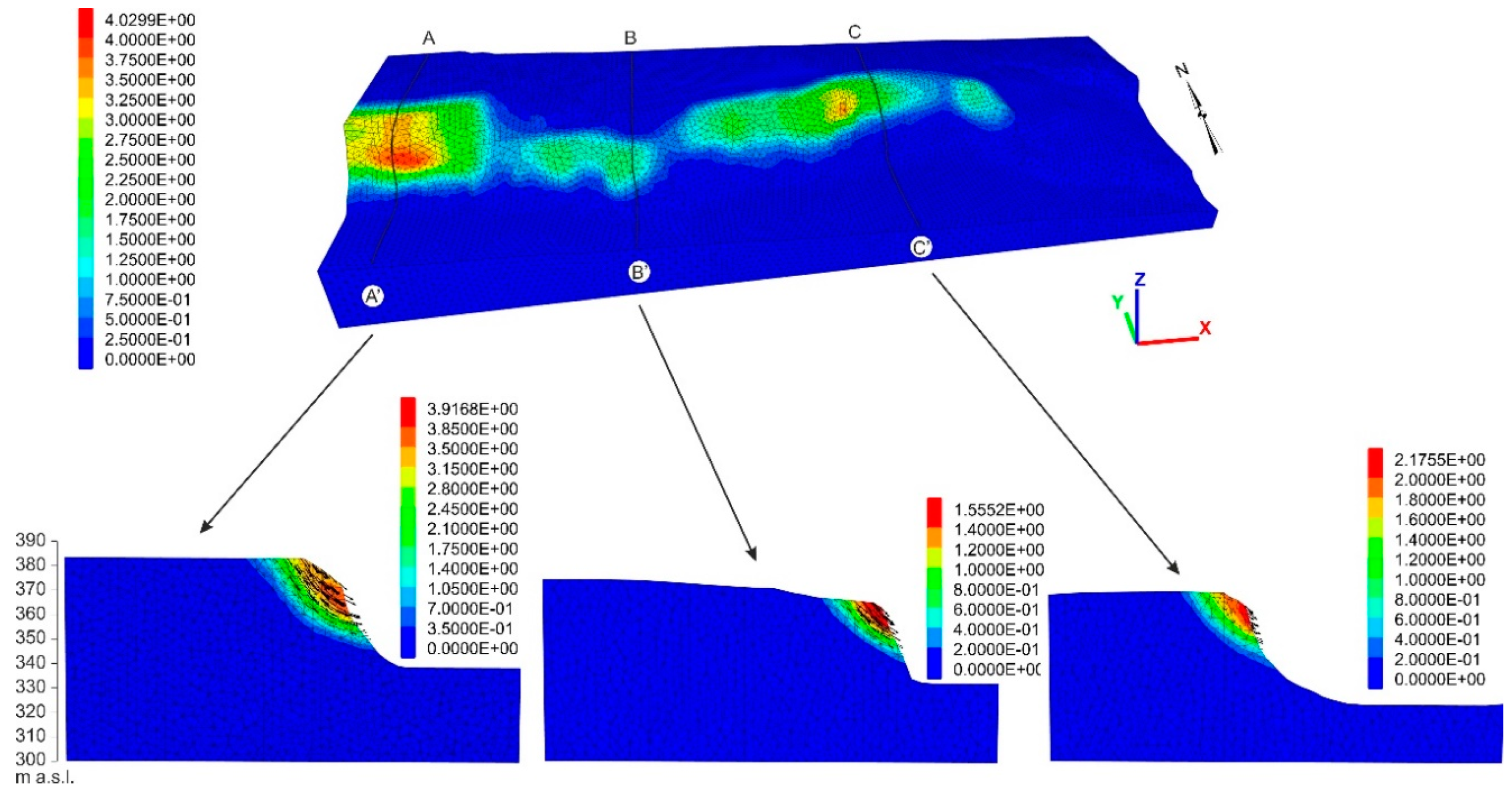
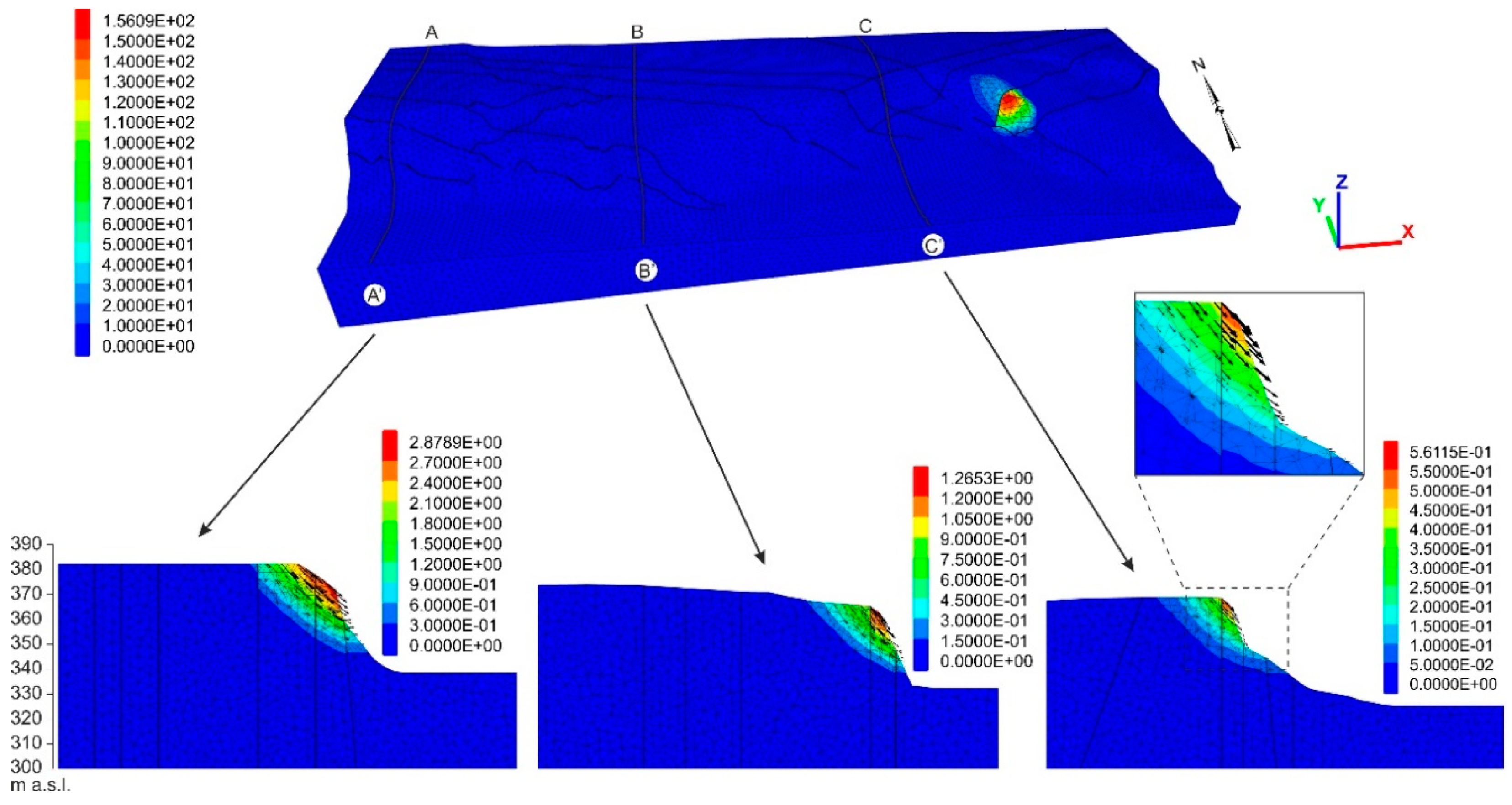
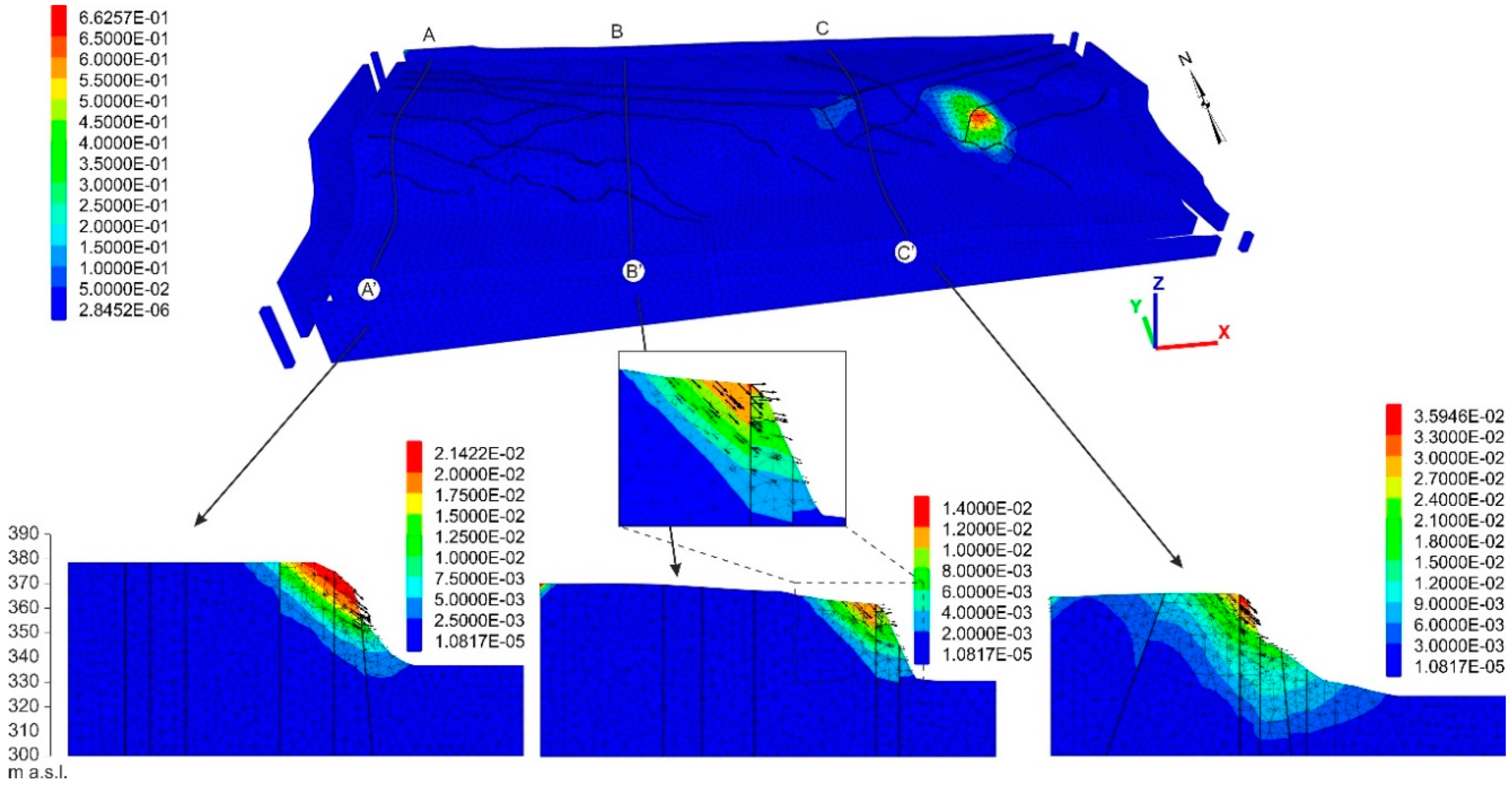
| Station Code | TER |
|---|---|
| City, Region | Teramo, Abruzzo |
| Latitude [WGS84] | 42.65656 |
| Longitude [WGS84] | 13.68954 |
| Soil class (EuroCode8) | A |
| Topography category | T1—Flat surface, isolated slopes and cliffs with average slope angle i <= 15° |
© 2019 by the authors. Licensee MDPI, Basel, Switzerland. This article is an open access article distributed under the terms and conditions of the Creative Commons Attribution (CC BY) license (http://creativecommons.org/licenses/by/4.0/).
Share and Cite
Calista, M.; Miccadei, E.; Piacentini, T.; Sciarra, N. Morphostructural, Meteorological and Seismic Factors Controlling Landslides in Weak Rocks: The Case Studies of Castelnuovo and Ponzano (North East Abruzzo, Central Italy). Geosciences 2019, 9, 122. https://doi.org/10.3390/geosciences9030122
Calista M, Miccadei E, Piacentini T, Sciarra N. Morphostructural, Meteorological and Seismic Factors Controlling Landslides in Weak Rocks: The Case Studies of Castelnuovo and Ponzano (North East Abruzzo, Central Italy). Geosciences. 2019; 9(3):122. https://doi.org/10.3390/geosciences9030122
Chicago/Turabian StyleCalista, Monia, Enrico Miccadei, Tommaso Piacentini, and Nicola Sciarra. 2019. "Morphostructural, Meteorological and Seismic Factors Controlling Landslides in Weak Rocks: The Case Studies of Castelnuovo and Ponzano (North East Abruzzo, Central Italy)" Geosciences 9, no. 3: 122. https://doi.org/10.3390/geosciences9030122
APA StyleCalista, M., Miccadei, E., Piacentini, T., & Sciarra, N. (2019). Morphostructural, Meteorological and Seismic Factors Controlling Landslides in Weak Rocks: The Case Studies of Castelnuovo and Ponzano (North East Abruzzo, Central Italy). Geosciences, 9(3), 122. https://doi.org/10.3390/geosciences9030122







